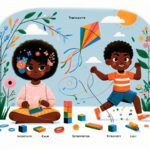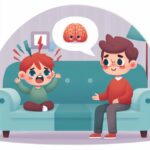Understanding toddler emotions and effective response strategies is crucial for every parent or caregiver. Toddlers are at a stage of rapid emotional development, and navigating their feelings can be a challenging yet rewarding journey. This article will delve into the nuances of toddler emotions and present strategies that can help in effectively responding to them.
Recognizing the Signs: Interpreting Toddler Emotions
Toddlers might not always have the words to express how they feel, but they communicate through behavior. Recognizing the signs of different emotions in toddlers is the first step in understanding toddler emotions and effective response strategies. From the exuberance of joy to the frustration of anger, each emotion leaves clues in their behavior.
Observation is key. Look for physical signs such as facial expressions, body language, and even changes in activity levels. A child who is happy will likely be more animated and eager to engage, while a frustrated toddler might clench their fists, frown, or have a tantrum. By paying attention to these signs, caregivers can better understand what the child might be feeling.
Understanding Toddler Emotions and Effective Response Strategies
Once you’ve recognized an emotion, responding in a way that validates the child’s feelings is critical. It’s important to acknowledge their emotions and let them know it’s okay to feel whatever they’re feeling. For example, saying ‘I see you’re upset because you can’t play outside right now. It’s okay to feel sad about it,’ helps toddlers understand their emotions are valid.
Educational resources like the one from Zero to Three provide additional insights into developing emotional intelligence in children. Strategies include engaging in comforting activities, setting boundaries, and using moments of emotional distress as teaching opportunities for coping skills.
Effective Communication: Building a Bridge to Your Toddler
Communication plays a pivotal role in understanding toddler emotions and effective response strategies. It’s about more than just talking; it’s about connecting on a level that your toddler can understand. Simplify your language and use short, concise sentences to explain feelings and reactions.
Active listening is also vital. Encourage your toddler to express their emotions by asking open-ended questions and paying full attention to their responses. This not only helps them feel heard but also teaches them how to articulate their feelings better.
In conclusion, understanding toddler emotions and effective response strategies require patience, observation, and active communication. By recognizing the signs of emotions, validating your child’s feelings, and engaging in effective communication, you can foster a nurturing environment that promotes emotional intelligence and strengthens the bond between you and your toddler. Remember, each child is unique, and what works for one may not work for another. Continuously adapting and learning is part of the journey in raising emotionally intelligent children.
For parents seeking more insights into managing their own emotions and fostering a positive home environment, exploring resources like The Importance of Self-Care for New Parents, Effective Communication with Your Partner After Having a Baby, and Managing Parental Anxiety: Techniques for Staying Calm and Centered can be incredibly beneficial.
Remember, the journey of understanding toddler emotions is not just about managing challenging behaviors but also about celebrating the joyful moments and the incredible bond it creates between you and your child.













